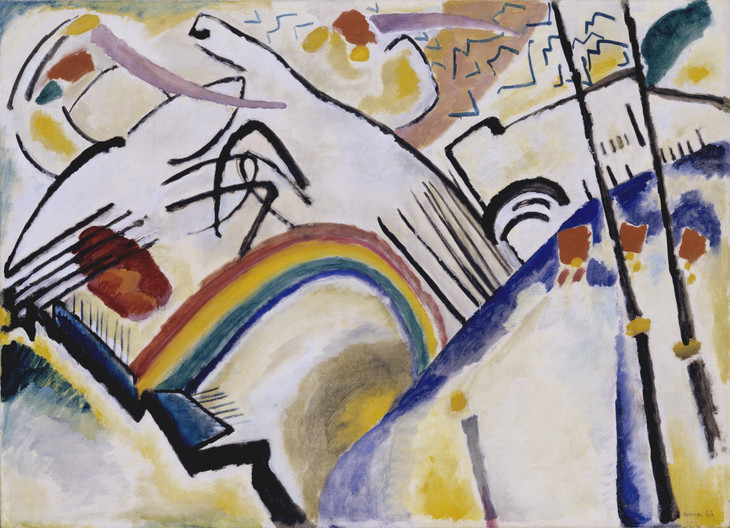Sublime Spirituality: Wassily Kandinsky’s Cossacks
Philip Shaw
Wassily Kandinsky’s painting Cossacks (Tate N04948, fig.1) shimmers between naturalism and abstraction. On the one hand it is possible to discern the elements of a recognisable landscape: three orange-helmeted cavalrymen in the foreground; a cheerfully rendered rainbow in the middle ground; a horizon made up of jagged, mountainous forms; a flock of birds gathering in the sky. On the other hand, the reduction of these representational figures to basic black lines and blotches of primary colour, together with the absence of perspective, lends the work a peculiarly abstract, pattern-like quality. As we shall see, there are echoes here of the ancient theory of the lightning-like sublime effect, albeit in modernist form.
Painted between 1910 and 1911, Cossacks is an expression of Kandinsky’s belief in the power of art ‘to awaken this capacity for experiencing the spiritual in material and in abstract phenomena’.1 The dynamic tension between abstract form and concrete content may be read as a manifestation of the wider conflict between the forces of political oppression – Kandinsky had been deeply moved by the strikes and upheavals in Odessa a few years earlier – and the hunger for spiritual rejuvenation consequent upon the rise of soulless modernity. Like his contemporaries Piet Mondrian and Henri Matisse, Kandinsky saw painting as an extension of religion, capable, as he wrote in his Reminiscences (1913), of revealing ‘new perspectives and true truths’ in ‘moments of sudden illumination, resembling a flash of lightning’.2 The echo of the Ancient Greek writer Longinus’s notion of sublime speech, which similarly strikes like a bolt of lightning, is carried over into Kandinsky’s description of the spiritual mission of the modern artist. In his 1911 essay On the Spiritual in Art, he compares the life of the spirit to ‘a large, acute-angled triangle’, at the apex of which stands the solitary artistic genius dispensing spiritual food to the multitudes below.3
Notes
Philip Shaw is Professor of Romantic Studies in the School of English at the University of Leicester and Co-Investigator of ‘The Sublime Object: Nature, Art and Language’.
How to cite
Philip Shaw, ‘Sublime Spirituality: Wassily Kandinsky’s Cossacks’, in Nigel Llewellyn and Christine Riding (eds.), The Art of the Sublime, Tate Research Publication, January 2013, https://www

